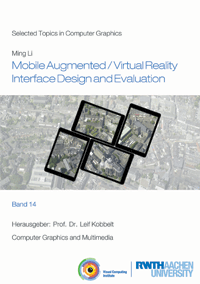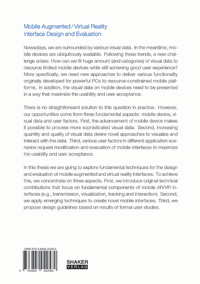
Shop : Details
Shop
Details
49,80 €ISBN 978-3-8440-4258-0Softcover212 pages80 figures285 g21 x 14,8 cmEnglishThesis
April 2016
Ming Li
Mobile Augmented/Virtual Reality Interface Design and Evaluation
Nowadays, we are surrounded by various visual data. In the meantime, mobile personal devices are ubiquitously available. Following these trends, a new challenge arises: How can we fit huge amount (and categories) of visual data to resource limited mobile devices while still achieving good user experience? More specifically, we need new approaches to deliver various functionality originally developed for powerful desktop computers to resource-constrained mobile platforms. In addition, the visual data on mobile devices need to be presented in a way that maximize the usability and user acceptance.
There is no straightforward solution to this question in practice. However, our opportunities come from three fundamental aspects: mobile device, visual data and user factors. First, the advancement of mobile device makes it possible to process more sophisticated visual data. Second, increasing quantity and quality of visual data desire novel approaches to visualize and interact with the data. Third, various user factors in different application scenarios request modification and evaluation of mobile interfaces to maximize the usability and user acceptance.
In this thesis we are going to explore fundamental techniques for the design and evaluation of mobile augmented and virtual reality interfaces. To achieve this, we concentrate on three aspects. First, we introduce original technical contributions that focus on fundamental components of mobile AR/VR interfaces (e.g., transmission, visualization, tracking and interaction). Second, we apply emerging techniques to create novel mobile interfaces. Third, we propose design guidelines based on results of formal user studies.
There is no straightforward solution to this question in practice. However, our opportunities come from three fundamental aspects: mobile device, visual data and user factors. First, the advancement of mobile device makes it possible to process more sophisticated visual data. Second, increasing quantity and quality of visual data desire novel approaches to visualize and interact with the data. Third, various user factors in different application scenarios request modification and evaluation of mobile interfaces to maximize the usability and user acceptance.
In this thesis we are going to explore fundamental techniques for the design and evaluation of mobile augmented and virtual reality interfaces. To achieve this, we concentrate on three aspects. First, we introduce original technical contributions that focus on fundamental components of mobile AR/VR interfaces (e.g., transmission, visualization, tracking and interaction). Second, we apply emerging techniques to create novel mobile interfaces. Third, we propose design guidelines based on results of formal user studies.
Keywords: mobile device; visualization; interaction; human factor; design; evaluation; augmented reality
Available online documents for this title
You need Adobe Reader, to view these files. Here you will find a little help and information for downloading the PDF files.
Please note that the online documents cannot be printed or edited.
Please also see further information at: Help and Information.
Please also see further information at: Help and Information.
| Document |  | Document | ||
| Type |  | |||
| Costs |  | 37,35 € | ||
| Action |  | Purchase in obligation and download the file | ||
| Document |  | Table of contents | ||
| Type |  | |||
| Costs |  | free | ||
| Action |  | Download the file | ||
User settings for registered online customers (online documents)
You can change your address details here and access documents you have already ordered.
User
Not logged in
Export of bibliographic data
Shaker Verlag GmbH
Am Langen Graben 15a
52353 Düren
Germany
Am Langen Graben 15a
52353 Düren
Germany
Mon. - Thurs. 8:00 a.m. to 4:00 p.m.
Fri. 8:00 a.m. to 3:00 p.m.
Fri. 8:00 a.m. to 3:00 p.m.
Contact us. We will be happy to help you.



